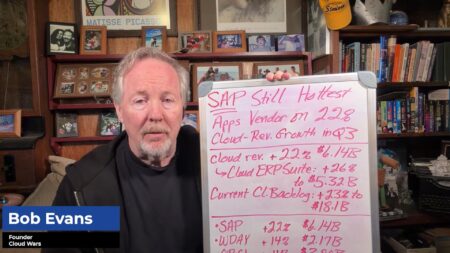Obliterating all growth expectations with a 110% spike in fiscal Q3 revenue, Snowflake is soaring because of its intense focus on industry-specific solutions, according to multiple comments from CEO Frank Slootman during its earnings call this week.
On my weekly Cloud Wars Top 10 rankings, hypergrowth Snowflake is #9. For the three months ended Oct. 31, that 110% growth rate pushed product revenue to $312 million.
Anyone doubting that industry clouds represent the future of the tech business should take a gander at Slootman’s remarks on Snowflake’s Dec. 1 earnings call, during which he made it unmistakably clear that his sales team’s ability to get inside the inner workings of their customers’ businesses, industries, concerns, language, and opportunities has been the primary reason for the company’s phenomenal Q3 performance.
Claiming that Snowflake salespeople “are now becoming experts at their [customers’] business,” Slootman responded to a question about the source of the 110% Q3 blowout by saying, “Demand comes from many different places, and over the last year our sales teams are being redirected to really understand the customers’ context.
“What are their challenges? What are people doing? What are people not doing? How are they approaching it? Because once we know that, we can bring that unique value to our customers so it’s no longer ‘Hey, here’s our architecture versus the next guy’s’ and ‘Let’s benchmark and POC these workloads to see how they do.’
“That was historically what Snowflake did. But now, we’ve completely leaned into the customers’ context: what are their issues, their challenges. And we are becoming experts at their business, and that is a big evolution,” Slootman said.
“It’s very exciting because it also elevates us inside the enterprise where we’re no longer talking exclusively to IT types and CIOs and so on, but we’re now also talking to the business side along with IT.
“And this is a very different conversation.”
This follows closely Snowflake’s introduction of industry-specific data clouds for financial services and for media several weeks ago. And while Slootman did not state that other industry clouds would follow, the context of his overall comments is making that pretty much a foregone conclusion.
Right near the beginning of his opening comments, Slootman set the stage.
“Vertical-industry focus is an important evolution of our selling motion, especially in global enterprise accounts. During the quarter, we announced two industry data clouds: the Financial Services Data Cloud brings together the Snowflake platform, partner solutions, and industry data to help financial-services organizations mobilize their data. And customers can launch products, build fintech platforms, and accelerate their compliance on top of Snowflake,” Slootman said.
With Snowflake’s Media Data Cloud, media companies and related firms can not only share data about audience behaviors but also also, within Snowflake-enabled “data clean rooms,” design collaborative arrangements and opportunities.
Among the media companies deploying that data clean room approach is Disney Advertising Sales, which Slootman said is working Snowflake to create “data collaboration for compliant and secure advertising.”
Some other gems from Slootman about the massive impact of industry solutions:
“Network effects” by industry
“You definitely see network effects but not so much by an enterprise or by an institution, but really by industry because the industry and sub-industry, they really induce and invoke a network effect because the entities have relationships and do business together. With both the Financial Services Data Cloud and the Media Data Cloud, there’s a huge amount of network effect in that area,” Slootman said. With the advertising business under tremendous pressure, he said, “There’s this whole movement afoot to enrich data for advertising yield and effectiveness. And as we enrich data, you know, that triggers new strategies around data sharing and data attribution.”
The “direct to consumer” tsunami
“You’ve really got to view it in the context of how the whole world is going direct to consumer. Every industry—even ones that have historically not been direct-to-consumer—are going that way. Obviously that triggers enormous investments and people trying to get up to speed on data operations, data science, and being able to run a real data-driven enterprise. And in order to do that, they need to have very, very, very refined data-enrichment strategies to really tune and optimize and make these relationships work, and we can do that with them.
“That’s what’s fueling this enormous focus on data sharing and being able to enrich their data with attributes that come from other sources. So, the ability to own your own data as an institution, as an enterprise, and to fully operationalize and mobilize it is going to become incredibly important. Even industries that historically have not been direct-to-consumer—I think of brick-and-mortar retail—they’re all changing now under the influence of the likes of Instacart and DoorDash.
“It’s all changing! So this interaction method and everybody becoming digital is a real tailwind for companies like Snowflake.”
“Why verticalization is such an important trend”
“Historically we’ve worked on legacy workloads, on-premise workloads, and we had a very predictable pattern: we’re moving data to the cloud and migrating databases. That is a tried-and-true part of our business.
“But the reason why verticalization is such an important trend has very little to do with legacy workloads, and it has everything to do with preparing companies for their digital direct-to-consumer futures where they’re trying to really mobilize data, monetize data, and make data really the core of what they’re doing. And this is not just in those enterprises that you’d typically think of…
“Everybody is realizing they’re sitting on something extraordinarily valuable if they can enrich it and mobilize it in the right way.”
And finally, one analyst asked the question that came up several times during the Q&A session: what triggered this massive acceleration of Snowflake’s business?
CFO Mike Scarpelli offered a couple of detailed answers and then Slootman interjected with a single word: “Verticalization.”
Slootman then underscored his point: “That whole Media Data Cloud, not to mention the Financial Services Data Cloud, those are huge things for us. And I think our salespeople are getting much better at selling the business value into those verticals.”
Yes indeed—110% better.
RECOMMENDED READING
Amazon Invades Wall Street as Industry-Cloud Boom Rolls On
Salesforce Puts ServiceNow in Crosshairs: Slack Attack Coming
Google Cloud CEO Thomas Kurian Unplugged: Innovation, Data & the Future
IBM Bullish on Industry Clouds: 5 Reasons Why
IBM Cloud Seeks Peace, not War, with Amazon, Google and Microsoft
Market Cap Madness: Salesforce + Snowflake + Workday = $500 Billion
RECENT PODCAST EPISODES
Google Cloud CEO Thomas Kurian Unplugged
Subscribe to the Industry Cloud Newsletter, a free biweekly update on the booming demand from business leaders for industry-specific cloud applications.








